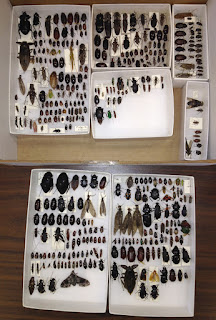As I’ve mentioned a couple times previously, the coastal
plain has been calling my name, and I’m now even involved in a large-scale
proposal to get a better handle on the insect diversity in the eastern US
lowlands. However, my ‘boots on the ground’ time in the lowcountry has been
minimal, a situation I’ve been eager to rectify. So this past week, a team from
my lab (Master’s student Anthony Deczynski, postdoctoral fellow Shelley Myers
and myself) made a 5-day visit to the Baruch Institute in the coastal flats of
Georgetown County, South Carolina. It was productive and eye-opening.
The Baruch Institute is a research station operated by
Clemson on the grounds of the Baruch Foundation’s ‘Hobcaw Barony’ a collection
of lands formerly owned by the Baruch family, willed to the state by Belle
Baruch to establish a research preserve. Hobcaw inclues a mosaic of marine,
freshwater, and terrestrial habitats, with the nonmarine areas dominated by
pine woodlands and cypress swamps. For our first visit we wanted to sample a
little of everything that the area had to offer, and managed to do a pretty
good job of that.
For our main sampling sites we selected to different areas
of pine forest, one that had been part of a regular burning rotation to
maintain the open grassland character of the understory. The other had escaped
fire for over 40 years, allowing a dense and lush understory to develop. Fire
has probably been a constant feature of these woodlands throughout their
evolution, and many rare plants rely on fire for regeneration, so the grassland
is likely the most natural state. Nonetheless, seeing what might be living in a
larger late successional example made for a potentially interesting comparison.
Our third site was down in the lowland swamp, right along the edge of
permanently flooded cypress-tupelo woodland.
In each of these sites we employed a number of traps,
including flight intercept traps…
While these traps did their work we beat, swept, debarked,
and generally scoured the surroundings for more cryptic beetle species. We also
took a couple side trips to nearby and complementary habitats.
A trip to the beach was essential, yielding a great
diversity of beetles washed up with the tides, as well as a selection of dune
and coastal scrub specialist species. This area, adjacent to the exclusive
DeBordieu Colony, also hosted some interesting maritime forest, a mix of shorter
pine and oak, with a rich understory growing in mostly sandy soils.
Each night of course we broke out the blacklights, running
at least two and as many as four each night in various places.
So, what about the beetles? There were a lot of them (most
of which still remain unmounted)! We had arrived in the immediate wake of
Tropical Storm Ana, so I think that the rains followed by heat and high
humidity triggered a lot of activity. Our first night was by far our best,
yielding an incredible diversity and abundance of species. Some of the
highlights were Polyphylla (probably occidentalis), Phileurus truncatus (and many of its larvae),
numerous Monochamus (carolinensis?), a smattering of smaller longhorns, several
specimens of a very large Chlaenius, ceratocanthine scarabs, and a great
abundance of small staphylinoids (scyds, pselaphines, and staphs proper) and cucujoids. Subsequent nights were not as exceptional, but also very
productive.
Here's Anthony's hands full of Phileurus larvae.
Below is a shot of what was pinnable after the first couple days and nights.
Here's Anthony's hands full of Phileurus larvae.
Below is a shot of what was pinnable after the first couple days and nights.
We are still sorting and just getting started mounting the
smaller stuff, including a couple good litter samples (one with Adranes, a
funny clavigerine pselaphine). The pointing is ongoing, although a little sampler is shown below. I’ll plan to update
with more details and photos on that material soon.
My working beetle list for the trip has 285 species, and I'd guess there will likely be close to 400 when all is said and done.
[Thanks to Shelley for all of the trap photos.]










Wait a minute, I see several non-beetles pinned there!
ReplyDeleteImpressive haul!
ReplyDelete